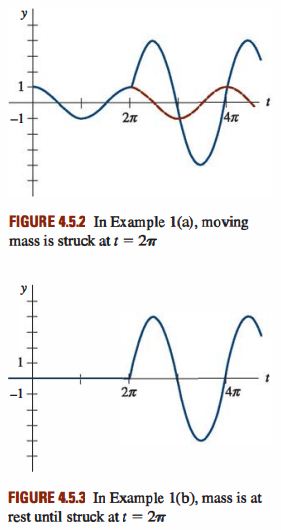Question 4.5.1: Solve y" + y = 4δ(t - 2π) subject to (a) y(0) = 1, y'(0) = 0......
Solve y^{\prime \prime}+y=4 \delta(t-2 \pi) subject to
(a) y(0)=1, \quad y^{\prime}(0)=0
(b) y(0)=0, \quad y^{\prime}(0)=0.
The two initial-value problems could serve as models for describing the motion of a mass on a spring moving in a medium in which damping is negligible. At t=2 \pi the mass is given a sharp blow. In part (a) the mass is released from rest 1 unit below the equilibrium position. In part (b) the mass is at rest in the equilibrium position.
Learn more on how do we answer questions.
(a) From (3)
\mathscr{L}\left\{\delta\left(t-t_0\right)\right\}=e^{-s t_0} . (3)
the Laplace transform of the differential equation is
s^{2} Y(s)-s+Y(s)=4 e^{-2 \pi s} \quad \text { or } \quad Y(s)=\frac{s}{s^{2}+1}+\frac{4 e^{-2 \pi s}}{s^{2}+1} \text {. }
Using the inverse form of the second translation theorem, we find
y(t)=\cos t+4 \sin (t-2 \pi) \mathscr{U}(t-2 \pi)
Since \sin (t-2 \pi)=\sin t, the foregoing solution can be written as
y(t)=\left\{\begin{array}{lr} \cos t, & 0 \leq t<2 \pi \\ \cos t+4 \sin t, & t \geq 2 \pi \end{array}\right. (5)
In FIGURE 4.5.2 we see from the graph of (5) that the mass is exhibiting simple harmonic motion until it is struck at t=2 \pi. The influence of the unit impulse is to increase the amplitude of vibration to \sqrt{17} for t>2 \pi.
(b) In this case the transform of the equation is simply
Y(s)=\frac{4 e^{-2 \pi s}}{s^{2}+1},
and so
\begin{aligned} y(t) & =4 \sin (t-2 \pi) \mathscr{U}(t-2 \pi) \\ & =\left\{\begin{array}{lr} 0, & 0 \leq t<2 \pi \\ 4 \sin t, & t \geq 2 \pi. & (6) \end{array}\right. \end{aligned}
The graph of (6) in FIGURE 4.5.3 shows, as we would expect from the initial conditions, that the mass exhibits no motion unil it is struck at t=2 \pi.
